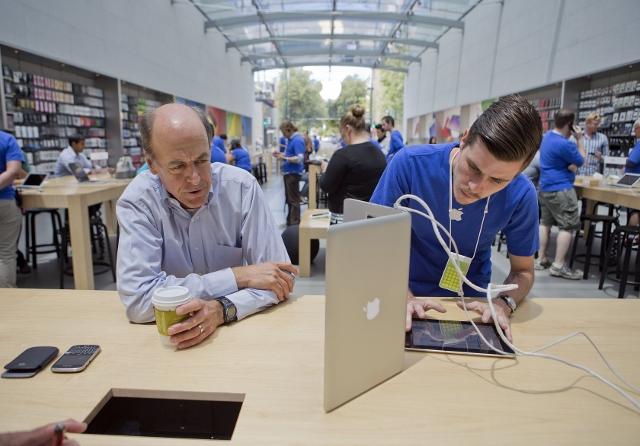Troy Wolverton: Apple out of touch with both fans and average consumers
Apple Genius Daniel Brewster, right, helps Chris Berka, of Portola Valley, with a start-up problem on his MacBook Pro at the Apple Store in Palo Alto, Calif., May 20, 2014. (LiPo Ching/Bay Area News Group/MCT)
November 15, 2016
By Troy Wolverton
Apple is looking more and more like it’s lost its way.
Revenue and earnings are falling. Sales of all its major products are in decline. Numerous individual products are getting long in the tooth, waiting years for updates. Even for products that are getting refreshed, the updates are underwhelming.
Some of this might be understandable if the company were focusing on new products that will likely pay off big in the future. But the last new product the company launched — Apple Watch — looks increasingly like a dud. Apple’s long-baking TV project has amounted to nothing; the company’s never released either an Apple-branded television or TV service. And, with every new report that comes out, the company’s “Titan” car project looks more and more like an expensive debacle.
Apple established itself as the premium brand, the one everyone envied, with an enthusiastic customer base. Under Steve Jobs, it made a concerted effort to reach out to new customers with lower priced products such as the iPod shuffle or the Mac Mini. Those worked the same way that an entry-level Mercedes does — they get people in the door and attached to the brand.
Now it seems to have lost touch, and others are passing it by.
Windows laptop makers like Razer recently have been releasing the kind of high-powered but elegantly designed machines that we used to expect from Apple. Microsoft just showed off an innovative touchscreen all-in-one desktop computer that’s clearly targeted at the kind of creative professionals who have been loyal to Apple for years. And Google, Roku and Amazon are offering digital streaming devices that not only cost less than Apple TV, they support new standards like 4K and high-dynamic range video that it doesn’t.
During a conference call with financial analysts last month after Apple reported its latest quarterly results, CEO Tim Cook bristled at some pointed questions from Steve Milunovich, an analyst with UBS, about the company’s strategy and direction.
“We have the strongest pipeline that we’ve ever had and we’re really confident about the things in it, but as usual, we’re not going to talk about what’s in it,” Cook said.
When pressed by Milunovich about whether the company had a “strong sense” of how the technology market was changing and how quickly it could respond to those changes, Cook answered curtly: “We have a strong sense of where things go, and we’re very agile to shift as we need to.”
Despite Cook’s assertions, Apple, the company that always seemed to know what consumers would want before they knew it themselves, is now making products that may seem cool in Cupertino, Calif., but don’t offer what customers want and are priced beyond what most can afford.
“Apple no longer makes anything I care to buy,” Seth Lewin, a self-described longtime Apple customer, posted in a comment on a tech blog. “Apple could care less what its customers think or say or want, it seems.”
We got a glimpse of this last year when Apple rolled out the new Macbook, a laptop that’s both costly, at least for its target audience of consumers, and crippled. The $1,300 computer comes with an uncomfortably thin keyboard that’s painful to type on and only one port that you can use to plug in things like external drives. You’ll almost certainly have to buy some adapters for the computer, because that one port is so new that almost no devices support it yet. Oh, and if the computer’s running out of power, you could be in a fix; you have to plug in its charger to the same port.
We got another glimpse of Apple’s cluelessness more recently when it unveiled the new iPhone, a device that was difficult to distinguish from last year’s model, yet still priced the same. One of the few clear differences: Apple in the new model removed the headphone jack, a decision basically no one was calling for. It’s a move that ticked off many users, worried others — and promised to make many folks’ lives more difficult by making it that harder to connect the iPhone to older audio equipment.
But the company’s recent press event may be the best indication of how out of touch it is these days.
In the past, Apple has used such events to refresh its Mac lineup, roll out new iPads or update its Apple TV streaming device. With many of its products in those categories a year or more old — and sales falling in nearly all of them, as best we can tell — you might have thought Apple would have updated several at least, particularly its lower-priced, consumer-targeted models.
Instead the company updated one product — the MacBook Pro. That computer line was certainly due for an update. But the MacBook Pro is a relatively pricey laptop targeted at professional users, an important but niche audience. Even if Apple scored a direct hit with them, a new MacBook Pro line by itself won’t revive Apple’s flagging computer sales.
Apple unveils new notebook lineup
The new computers have a cool feature: a touch sensitive bar called the Touch Bar that will display different buttons and features depending on what program is being used. But right now, the Touch Bar is only available on models that start at $1,800, a pricey sum even for professionals. And even as Apple was adding the new Touch Bar, it was taking away or excluding features that professional want and need.
Many potential customers criticized the new computers for being underpowered in terms of their graphics processors and the amount of memory they can support. Others hated the fact that the new computers, like the Macbook before them, only have USB-C ports, which means they’d have to buy lots of dongles to attach their older hard drives, external monitors, cameras and the like. Unlike the older MacBook Pro models, the new ones won’t have an SD card slot, so users will have to have another dongle to upload photos and videos saved to one.
The take of Michael Tsai, a Mac developer, was typical of Apple’s core fans.
“I was really disappointed with today’s Apple event,” wrote Tsai on his blog. “It seems like Apple has either lost its way, that it has lost touch with what (some of) its customers want, or that it simply doesn’t care about those customers.”
And, let’s be clear, this backlash was against a product that Apple had actually revamped and had, based on its recent standards, been updating regularly. Other products — and their fans — haven’t been so lucky.
It would be one thing if the rest of the market were standing still or if Apple’s products were so far beyond the competition that the company could afford to stand pat or if the company’s sales were continuing to grow gangbusters despite its neglect. But none of those things is true.
And that’s not to mention all the new markets from smart home products to virtual and augmented reality that Apple is basically ignoring.
But, hey, that Touch Bar sure looks neat. I just hope Apple executives aren’t shocked when it doesn’t spark a rebound for the company.








